![]()
![]()
![]()
Use LEFT and RIGHT arrow keys to navigate between flashcards;
Use UP and DOWN arrow keys to flip the card;
H to show hint;
A reads text to speech;
31 Cards in this Set
- Front
- Back
|
What is the tissue whose osmolarity is maintained? |
Interstitial fluid in kidney |
|
|
Proximal tubule |
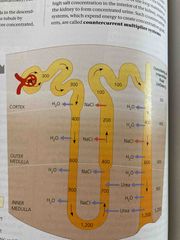
Filtrate volume decreases as water and salt are absorbed Osmolarity stays the same (it’s about 300) |
|
|
Descending limb of loop of Henle |
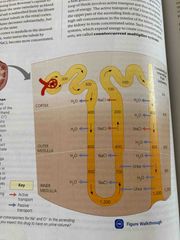
Solutes become more concentrated due to water leaving the tubule by osmosis because the interstitial fluid concentration goes up as you go closer to the medulla Filtrate also becomes concentrated bc its losing water There is also numerous water channels formed by proteins called aquaporin that allow diffusion into interstitial fluid |
|
|
Ascending limb of loop of henle |
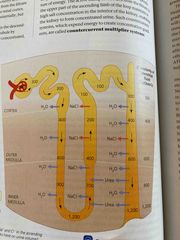
NaCl diffuses through bottom ascending. Does not have aquaporin proteins and the membrane that faces the filtrate is impermeable to water This maintains high osmolarity (concentration) in the interstitial fluid of the renal medulla At top of ascending, where it’s thicker, it becomes active transport from filtrate which makes it more dilute as it goes up to distal tube |
|
|
Juxtamedullary nephrons |
Contain the deep loop of henle |
|
|
Countercurrent multiplier systems |
Involving the loop of henle Maintains a high salt concentration in the kidney Like a countercurrent exchange system except that it expends energy |
|
|
Vasa recta and countercurrent exchange system |
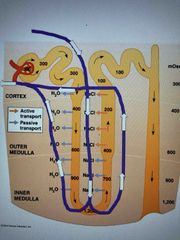
Supplies the kidney with nutrients without interfering with the osmolarity gradient Part of network fo capillaries that surrounds the tubules (the netting that surrounds the loop of henle) Blood goes down and back out, in countercurrent set up that allows blood supply in deep part of kidney where it gains salt and loses water while supplying nutrients to kidney, but then comes back up where it loses the salt and gains back the water so it does not continue on with salty blood to the rest of the body. |
|
|
Collecting duct |
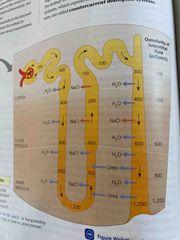
Osmosis extracts water from filtrate as it passes interstitial fluid of increasing osmolarity More aquaporins to diffuse water out Some active transport of NaCl before it gets to the bottom of duct Urine produced (about 1200 moles/ L) is isoosmotic to interstitial fluid of inner medulla but hyperosmotic to blood (300 mol/L) |
|
|
Adaptations to diverse environments |
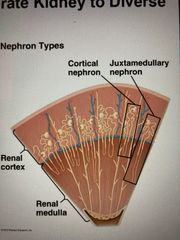
Variations in nephron structure and function Juxtamedullary nephron is key to conserving water Dry habitats=longer henle loops and more jux nephrons (ours is 1200 but dessert mouse is 9000) Fresh water =shorter loops |
|
|
Kidney function in vampire bats |
Feeds at night on blood and need to take in double the amount of their own weight which can impair flight Bc of this, they can release large amount of dilute urine so they can fly home Bc blood is highly protein-based and water is scarce, their kidneys can switch to creating small amounts of hyperosmotic urine to conserve water |
|
|
Birds and other reptiles |
Birds have short loops of henle and Do not rely on kidneys for water conservation. They conserve by excreting Uric acid instead of urea Other reptiles only have cortical nephrons but reabsorb water from waste in the cloaca |
|
|
Fish |
Freshwater: conserve salt in their distal tubes and excrete large volumes of dilute urine Amphibians: conserve water on land by reabsorbing in bladder Marine: hypoosmotic compared with environment so their kidneys have small glomeruli and some have none at all. Also filtration rate is low and very little urine is excreted |
|
|
Diuresis |
Increase production of urine |
|
|
Antidiuretic hormone (ADH) |
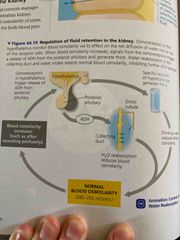
Osmoreceptor cells in hypothalamus that monitor blood osmolarity and regulate release of ADH from posterior pituitary (neuronal system vs anterior which is endocrine) When osmolarity rises above set point (300 mol/L), ADH release into blood stream increases |
|
|
How does ADH work? |
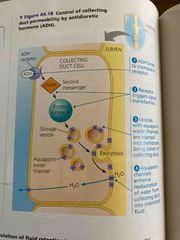
ADH bonds to receptors molecules on collecting duct and distal tubules This increases number of aquaporin proteins in the lumen side of collecting duct More water is absorbed from filtrate reducing urine volume and lowering blood osmolarity |
|
|
What also happens when hypothalamus increases ADH? |
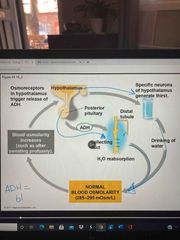
The hypothalamus triggers thirst because the ADH only conserves, doesn’t increase water |
|
|
ADH problems |
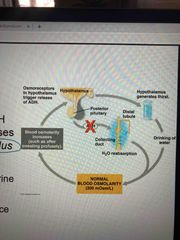
Alcohol is a diuretic bc it inhibits release of ADH, per more and higher salt concentration. Mutation in ADH production or in receptors causes diabetes insipidus Both cases: lots of dilute urine, dehydration, solute imbalance |
|
|
Renin-angiotensin-aldosterone system (RAAS) |
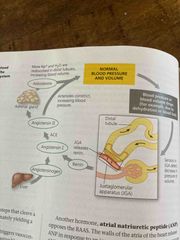
Part of a complex feedback circuit A drop in blood pressure near glomerulus causes the juxtaglomerular apparatus (JGA) -monitors blood pressure-to release enzyme renin Renin cleaves protein from liver angiotensinogen to form angiotensin I. Angiotensin I is then cleaves by ACE (another enzyme) to form Angiotensin II. |
|
|
2 jobs of angiotensin II |
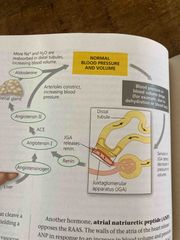
1. It causes vasoconstriction to increase blood pressure, decreases blood flow to kidneys 2. Stimulates aldosterone which increase absorption of NaCl and water in distal tubules and releasing back to interstitial fluid. This increases blood volume and and pressure |
|
|
Differences btw RAAS and ADH |
Both increase water and reabsorption ADH restores osmolarity RAAS responds to decrease blood pressure |
|
|
Atrial natriuretic peptide (ANP) |
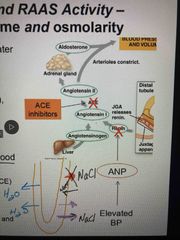
In walls of heart (atria) Oppose RAAS Elevated blood pressure/ volume, releases ANP which inhibits release of renin High blood pressure=reduce blood volume |
|
|
Angiotensin converting enzyme (ACE) |
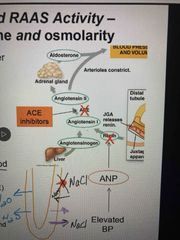
Blocks production of angiotensin II |
|
|
Diuretics |
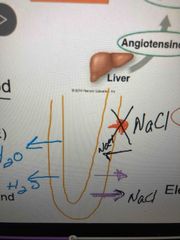
Lasix Inhibits active transport of Na at ascending loop and distal loop NaCl stays in filtrate and water follows salt so less water leaves filtrate Reduces blood volume to counter higher blood pressure |
|
|
Chronic kidney disease/ kidney failure |
Hypertension: leading cause of kidney disease bc damages blood vessels Arteries narrow and weaken and harden which limits blood flow to kidney=restricted filtration Damage to capillaries and glomerulus affect health of nephron cells and ability of glomerulus to filter HTN from diabetes Treat with dialysis or transplant |
|
|
Parathyroid hormone and vitamin D: control of blood calcium |
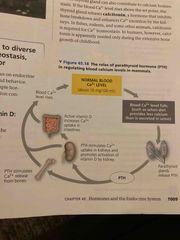
Calcium is in muscle contraction, nerve conduction and blood clotting If blood Ca falls: skeletal muscles contract convulsively (a fetal condition called tetany) If blood Ca rises: precipitates of Ca phosphate can form in body tissues leading to organ damage (metastatic calcification) |
|
|
2 antagonistic hormones regulate the homeostasis of Ca in blood |
Parathyroid hormone (PTH): released by parathyroid glands Calcitonin: released by thyroid gland |
|
|
Parathyroid glands |
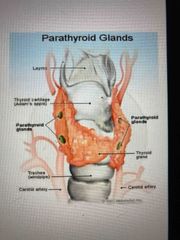
A set of 4 small glands on surface of thyroid Produce PTH Regulate blood Ca set point of 10mg/100mL |
|
|
When blood Ca falls.. |
Parathyroid glands release PTH PTH causes the mineralized matrix of bone to decompose (helped by osteoclasts) releasing Ca into the blood PTH stimulate reabsorption of Ca through renal tubules in kidneys Stimulates kidneys to activate vitamin D calcitriol which promotes uptake of Ca in intestine |
|
|
Calciferol |
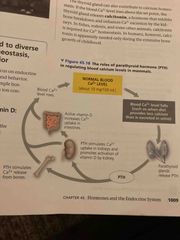
Inactive form of vitamin D obtained from food or made in skin Activation of vitamin D begins in liver and completes in kidney Active form of vitamin D acts on intestines to take in more Ca form food |
|
|
Osteoporosis |
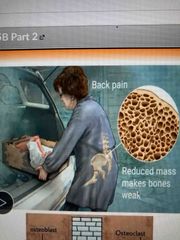
Bones become brittle and fragile from loss of tissue-lack of bone density Body typically replaces bone tissue but slows in replacing old bone tissue (remodeling) Due to hormonal changes or deficiency of calcium or vitamin D Tx: bisphosphonates |
|
|
Blood Ca level rises... |
Negative feedback loop inhibits release of PTH from PT glands Calcitonin: decreases blood Ca -stimulates Ca deposition in bones (helped by osteoblasts) -enhances Ca release in kidney Calcitonin is required in fish and rodents but is only needed in humans during childhood (bone growth extensive) |

